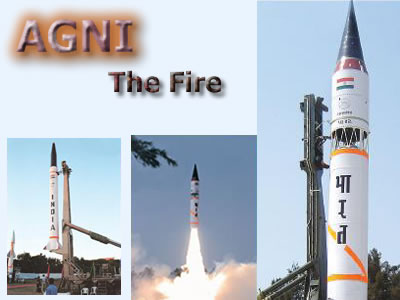India Successfully tested Agni 3 Missile- Ready for Army use
| A Brief News Video Showing The Launch Of Agni III |
Indian scientists achieved a major milestone in missile technology when they successfully conducted the flight test of the Intermediate Range
Ballistic Missile (IRBM) – AGNI III from the Wheeler Island, off the coast of Orissa on 7th feb. The 16 meter long missile weighing
48 tonnes, lifted off successfully from its Rail Mobile Launcher System leaving a trail of orange and yellow smoke. The missile which has a range of
more than 3000 kms is capable of carrying a pay load of 1.5 Tonnes. The AGNI-3 Missile tested for the full range, hit the target with pinpoint
accuracy and met all the mission objectives. Two down range ships located near the target have tracked and witnessed the Missile reaching the target
accurately.
The missile is equipped with a state of the art computer system, navigated with a most advanced Navigation system and guided with an innovative
guidance scheme. The Navigation system used for guidance is first of its kind. Number of Radars and electro optical tracking systems along the coast
of Odisha have monitored the path of the Missile and evaluated all the parameters in realtime.
The launch is part of the pre-induction trial. Indian Army (the user) has carried out the total launch operations guided by the DRDO scientists. Now
the Missile system will be fully inducted into the armed forces.
The achievement is of high degree of self reliance in AGNI III, as most of the sub systems have been developed within the country with the synergy between DRDO – Industry (both Public and Private sector) and Academia. As per the Mission Director, Shri Avinash Chander, many “firsts” have been established by this launch, which includes the Flex Nozzle Controls of Rocket Motor during powered phase, specially developed composite propellant with high specific impulse for the rocket. Guidance and Control with built in fault tolerant avionics, withstanding of severe aero thermal environment experienced during the Re-entry phase and coordinated mission management.
While the formal induction will take at least two more years and a few more tests, the missile is strategically vital in India’s nuclear deterrence plans that rely on the second strike theory. India’s stated policy has been of no first use, which makes it vital to have long range missiles to strike back in the event of a nuclear attack.
Immediately after the test, Defence Minister A K Antony congratulated DRDO for the success and called the successful test a ‘tremendous
achievement’.In a message to the scientists behind the project, Prime Minister Manmohan Singh said, “I convey my heartiest congratulations
to the DRDO, the Advanced Systems Laboratory, Hyderabad and all members of the Project Team for the successful launch of the Agni 3 missile. On behalf
of the Nation I commend our scientists and engineers for their dedication, hard work and excellence in our march towards achieving self-reliance in
high-technology areas and meeting the country’s defence needs.”
In Brief About Agni
 |
| India's Solid Deterrent - THE AGNI MISSILE |
The Agni missile (Sanskrit: Agnī "Fire") is a family of Medium to Intercontinental range ballistic missiles developed by India under the Integrated Guided Missile Development Program. As of 2008, the Agni missile family comprises three deployed variants:
- Agni-I short range ballistic missile, 500 - 700 Km range.
- Agni-II medium range ballistic missile, 2,000- 3,000 Km range.
- Agni III, an intermediate-range ballistic missile was developed by India as the successor to Agni II. Intended to be a two-stage ballistic missile capable of nuclear weapons delivery, it is touted as India’s nuclear deterrent against China. The missile is likely to support a wide range of warhead configurations, with a 3,500 km range and a total payload weight of 2490 kg. The two-stage solid fuel missile is compact and small enough for easy mobility and flexible deployment on various surface/sub-surface platforms.
- There will not be an Agni-IV missile, with DRDO leapfrogging from intermediate range Agni-III to a standard ICBM possibly.
- Agni-V intercontinental ballistic missile, 5000 - 6000 Km range (under development).
